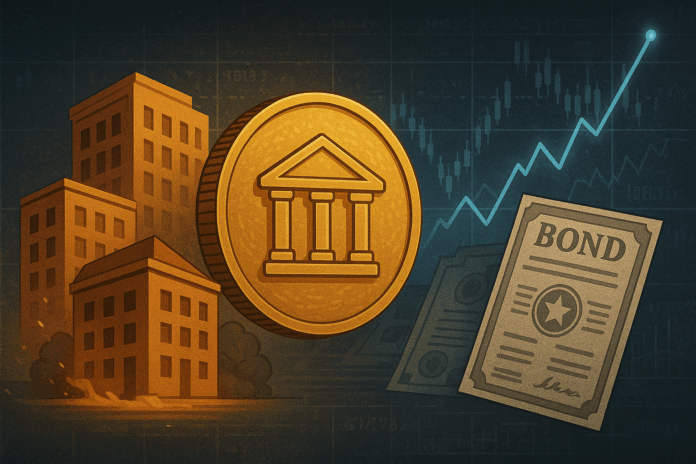For over a decade, the crypto industry has been dominated by speculative tokens—Bitcoin, Ethereum, and thousands of altcoins promising everything from decentralized finance to internet disruption. But in 2025, a new narrative is taking center stage: tokenized real-world assets (RWAs).
From U.S. Treasuries to real estate, equities to gold, financial institutions and blockchain innovators alike are increasingly converging on one idea—the next trillion-dollar opportunity in crypto isn’t another meme coin. It’s the real world, brought on-chain.
What Are Tokenized Real-World Assets?
Tokenized RWAs are digital representations of physical or traditional financial assets issued on a blockchain. These tokens are backed 1:1 by real assets and aim to provide the benefits of crypto—programmability, instant settlement, and global access—without the volatility and opacity of traditional altcoins.
Examples include:
-
Tokenized Treasury bills (e.g. Ondo Finance, Franklin Templeton, Backed)
-
Real estate and property shares (e.g. RealT, Tangible)
-
Gold-backed tokens (e.g. Paxos Gold, Tether Gold)
-
Equity-like tokens issued by regulated platforms
This is not just theoretical: As of mid-2025, more than $10 billion worth of U.S. government bonds have been tokenized on public blockchains. JPMorgan, BlackRock, and Citi have all launched or backed RWA pilots.
Why the Shift?
The shift to RWAs stems from growing fatigue with speculative assets and the increasing demand for yield, transparency, and regulatory clarity in blockchain.
-
Interest Rates Are Back: In a world of 4–5% Treasury yields, investors are asking why they should hold tokens that promise little utility or revenue. Tokenized T-bills offer high yield plus blockchain-native utility—decentralized lending, composability, and 24/7 settlement.
-
Compliance and Trust: Unlike anonymous altcoins, RWAs are typically issued by regulated entities with real-world enforcement mechanisms, increasing institutional trust.
-
Global Access to Safe Assets: Tokenized RWAs democratize access to stable, high-quality assets—especially in emerging markets where inflation erodes local currencies.
-
Better Infrastructure: The rise of permissioned chains (e.g. Avalanche Evergreen, Polygon zkEVM, and Base) and compliant DeFi protocols enables RWAs to live on-chain without regulatory risk.
Institutions Are Leading the Way
Major institutions have woken up to tokenized assets in a big way:
-
BlackRock launched its tokenized fund BUIDL on Ethereum in 2024, becoming the largest RWA fund on-chain within months.
-
Franklin Templeton now tokenizes short-term government securities natively on public blockchains.
-
JPMorgan’s Onyx platform processed billions in tokenized asset transfers using a custom permissioned chain.
Meanwhile, blockchain-native firms like Ondo Finance, Maple Finance, and Centrifuge are creating new financial primitives around RWAs—allowing users to borrow against tokenized T-bills or provide liquidity to private credit deals.The Altcoin Era: Hype vs. Substance
For years, the crypto market has been flooded with tokens that had little fundamental value—memecoins, governance tokens with no governance, and ecosystems driven by token incentives rather than product-market fit. These assets often fueled short-term speculation but lacked long-term utility.
The rise of RWAs offers a stark contrast: they represent existing economic value, not projected or hypothetical value. Instead of betting on which Layer-1 will win or which DeFi app will attract users, investors can now own real assets in a blockchain-native wrapper.
This appeals not only to institutions but also to conservative retail users burned by the volatility of Luna, FTX tokens, or countless “rug pulls.”
Risks and Challenges Remain
Despite their promise, RWAs come with trade-offs:
-
Counterparty risk: Trust in issuers is crucial. Token holders depend on custodians to maintain real-world backing.
-
Regulatory complexity: Securities laws apply. Many RWA platforms operate in tightly controlled jurisdictions.
-
Lack of composability: Tokenized assets often can’t be used freely across DeFi due to whitelisting and compliance restrictions.
Moreover, the question remains: can RWAs stay truly decentralized? Or are they just a better form of TradFi wrapped in blockchain branding?
A Bridge to the Real Economy
The ultimate promise of tokenized RWAs is not just bringing assets on-chain—it’s enabling new use cases:
-
Instant collateralization of real-world holdings
-
Borderless settlement of traditional financial products
-
Fractional ownership of illiquid assets like real estate or collectibles
-
Programmable money markets where traditional and crypto-native capital interact seamlessly
Some call it “TradFi 2.0.” Others see it as the bridge between the walled gardens of traditional finance and the open ecosystems of crypto.
Either way, it is redefining what it means to “own” something on-chain.
The Future: RWAs Over Altcoins?
We’re witnessing a structural shift in crypto—one that moves away from speculative narratives and toward utility-backed assets. Tokenized RWAs, backed by real-world value and supported by institutional momentum, offer a clearer path to adoption, regulation, and long-term relevance.
This doesn’t mean altcoins will disappear. Innovation will continue in decentralized identity, data marketplaces, Layer-2 scalability, and more. But in terms of capital allocation, yield-seeking behavior, and regulatory acceptance, RWAs are shaping up to be the new foundation of crypto’s next era.
Conclusion
Crypto was always about reinventing money, ownership, and finance. For years, it chased that dream through abstraction—new tokens, new chains, new visions. But in 2025, the most promising frontier may be the most grounded: bringing real-world assets on-chain.
As institutions move billions into tokenized securities, and retail users seek stable returns, the writing is on the wall: The future of crypto might not lie in the next altcoin pump—but in the digitization of the real world.



